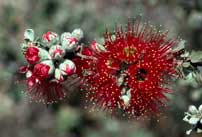In Flower This Week
A weekly news sheet prepared by a Gardens' volunteer.
Numbers before each plant refer to temporary IFTW labels in the gardens.
Numbers in square brackets [ ] refer to garden bed Sections. Plants in flower are in bold type.
View past issues of 'In Flower This Week'.
6 August 2014
Kunzea pulchella click for larger image |
Take a walk along the road behind the café and up the hill to see many plants in flower, including the early flowering wattles.
- Acacia podalyriifolia [Section 126], or Queensland Silver Wattle, on the right, has large golden balls of flowers on attractive grey-green foliage. It is a fast-growing small tree which is widely cultivated in its native Australia and is also naturalised in Malaysia, Africa, India and South America.
- Banksia spinulosa [Section 126], on your right, has large golden flowerheads held upright on toothed linear grey-green foliage. Sometimes known as the Hairpin Banksia, it grows along the east coast of mainland Australia from eastern Victoria to Cairns.
- Westringia eremicola [Section 126], or Slender Westringia, again on your right, has grey-green linear foliage with pale mauve flowers. It is endemic to south-eastern Australia.
- On your right-hand side, Grevillea ‘Poorinda Diadem’ [Section 126] is a tall straggly bush with many butterscotch-yellow flowers with long styles. It is a seedling selection from Grevillea 'Poorinda Leane' by Leo Hodge.
- Eremophila microtheca [Section 302], also on your right, is a wispy grey-foliaged bush with mauve tubular flowers. It is found on the coastal region of central WA. The leaves have a strong odour that some may find unpleasant.
- Grevillea aspleniifolia [Section 124], on your left, is a very large sprawling shrub with long linear toothed green foliage and red toothbrush flowers. It is endemic to New South Wales.
- Leucopogon melaleucoides [Section 110] is a small neat bush with dark green foliage and clusters of terminal white flowers. It is found naturally in northern New South Wales and southern Queensland.
- Turn right along the Main Path to see on your right Guichenotia ledifolia [Section 4], with grey-green foliage covered in masses of dusty pink 5-petalled flowers with maroon centres. It is native to south western WA.
- Kunzea pulchella [Section 15r], on your left, is a medium-sized bush with grey-green foliage and spectacular bright red “bottlebrush” flowers. It is endemic to the south-west of Western Australia, where it occurs on granite outcrops and slopes.
- Go up the steps to the road and turn left. A Thryptomene sp. [Section 14] on your left is an airy bush with a graceful, arching habit covered in clusters of tiny pink flowers with darker centres on close neat foliage.
- Acacia amoena [Section 3], or Boomerang Wattle, on your right, is a small bush with tough yellow-green leaves and golden balls of flowers. It is native to New South Wales and northern Victoria tablelands.
- Grevillea monticola [Section 14], on your left, has spiky “holly-like” foliage with many rusty orange buds which open to small white toothbrush flowers. It has bronze new growth which contrasts with its more usual blue-grey foliage. It is endemic to south-western WA.
- Acacia ‘Purpurea’ [Section 3] on your right has many sprays of golden ball flowers and striking silver-grey fringed foliage with a feathery texture. This showy form of Acacia baileyana is very fast-growing and tough and has deep purple new growth.
- Homoranthus cernuus [Section 15j], on your left, has tight grey foliage with prominent red buds in twos and threes that open to a cream flower with long exserted stamens. This erect slender shrub is rare in the wild, occurring SW of Muswellbrook, New South Wales, in Wollemi National Park.
- Grevillea iaspicula [Section 15h], on your left, also known as Wee Jasper Grevillea, is an endangered shrub that is endemic to southern New South Wales. It is a medium-sized bush with dense mid-green foliage and pink and cream flowers.
Rosalind Walcott
![Director of National Parks [logo]](../../../../images/dnp_90px.gif)







